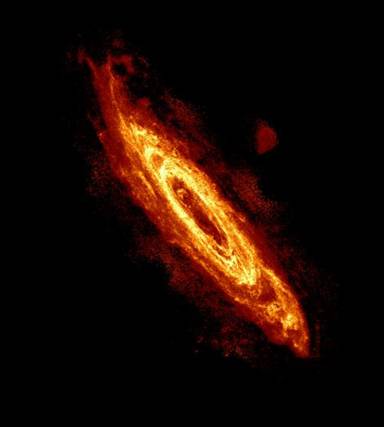

| The HI in a galaxy is often much more extended that the stellar light distribution, as shown by comparison of the two images here of M31, the Andromeda galaxy. The images are (pretty much) shown to the same scale. The HI disk is much larger than the stellar disk. Notice that there is a depression in the HI distribution in the center of the galaxy just where the stellar bulge is seen in the optical image. Because the HI extends much further out than the stellar light and because HI maps yield velocities as well, HI velocity fields can be used to derive rotation curves and to trace the total mass distribution to very large radii, far outside the stellar disk. In most galaxies, the HI rotation curve is flat at large radii, implying the existence of large quantities of dark matter. |

Image credit here... |

Image from Robert Braun. The scale is the same as the optical image to the left. |
 Another example of a galaxy whose HI disk is much larger than its
stellar disk is
NGC 5055;
see Battaglia, Fraternali, Oosterloo & Sancisi
2005, A&A.
Another example of a galaxy whose HI disk is much larger than its
stellar disk is
NGC 5055;
see Battaglia, Fraternali, Oosterloo & Sancisi
2005, A&A.